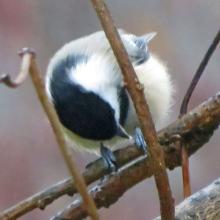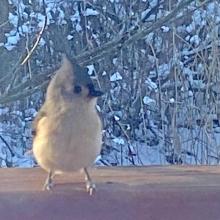Poecile atricapillus
Common name:
Black-capped chickadee
Genus:
Poecile
Family:
Paridae
Suborder:
-n/a-
Baeolophus bicolor
Common name:
Tufted titmouse
Genus:
Baeolophus
Family:
Paridae
Suborder:
-n/a-
Poecile atricapillus
Common name:
Black-capped chickadee
Genus:
Poecile
Family:
Paridae
Suborder:
-n/a-
Baeolophus bicolor
Common name:
Tufted titmouse
Genus:
Baeolophus
Family:
Paridae
Suborder:
-n/a-
Poecile atricapillus
Common name:
Black-capped chickadee
Genus:
Poecile
Family:
Paridae
Suborder:
-n/a-
Baeolophus bicolor
Common name:
Tufted titmouse
Genus:
Baeolophus
Family:
Paridae
Suborder:
-n/a-
Family-Animalia: paridae
The tits, chickadees, and titmice constitute the Paridae, a large family of small passerine birds which occur mainly in the Northern Hemisphere and Africa. Most were formerly classified in the genus Parus.
Members of this family are commonly referred to as "tits" throughout much of the English speaking world, but North American species are called either "chickadees" (onomatopoeic, derived from their distinctive "chick-a dee dee dee" alarm call) or "titmice". The name titmouse is recorded from the 14th century, composed of the Old English name for the bird, mase (Proto-Germanic *maison, Dutch mees, German Meise), and tit, denoting something small. The former spelling, "titmose", was influenced by mouse in the 16th century. Emigrants to New Zealand presumably identified some of the superficially similar birds of the genus Petroica of the family Petroicidae, the Australian robins, as members of the tit family, giving them the title tomtit, although, in fact, they are not related.
These birds are mainly small, stocky, woodland species with short, stout bills. Some have crests. They range in length from 10 to 22 cm (3.9 to 8.7 in). They are adaptable birds, with a mixed diet including seeds and insects. Many species live around human habitation and come readily to bird feeders for nuts or seed, and learn to take other foods.
Description
With the exception of the three monotypic genera Sylviparus, Melanochlora, and Pseudopodoces, the tits are extremely similar in appearance, and have been described as "one of the most conservative avian families in terms of general morphology". The typical body length of adult members of the family is between 10 and 16 cm (3.9 and 6.3 in) in length; when the monotypic genera are added, this range is from 9 to 21 cm (3.5 to 8.3 in). In weight, the family ranges from 5 to 49 g (0.18 to 1.73 oz); this contracts to 7 to 29 g (0.25 to 1.02 oz) when the three atypical genera are removed. The majority of the variation within the family is in plumage, and particularly color.
The bills of the tits are generally short, varying between stout and fine, depending on diet. The more insectivorous species have finer bills, whereas those that consume more seeds have stouter bills. It is said that tits are evolving longer beaks to reach into bird feeders. The most aberrant bill of the family is possessed by Hume's ground tit of Tibet and the Himalayas, which is long and decurved.
Distribution and habitat
The tits are a widespread family of birds, occurring over most of Europe, Asia, North America, and Africa. The genus Poecile occurs from Europe through Asia into North America, as far south as southern Mexico. American species in this genus are known as chickadees. Some species in this genus have quite large natural distributions; one, the grey-headed chickadee, is distributed from Scandinavia to Alaska and Canada. The majority of the tits in the genus Periparus are found in the southeastern portion of Asia. This includes two species endemic to the Philippines. The coal tit, also in this genus, is a much more widespread species, ranging from the British Isles and North Africa to Japan. The two crested tits of the genus Lophophanes have a disjunct distribution, with one species occurring in Europe and the other in central Asia.
The genus Baeolophus is endemic to North America. The genus Parus includes the great tit that ranges from Western Europe to Indonesia. Cyanistes has a European and Asian distribution (also into northern Africa), and the three remaining genera, Pseudopodoces, Sylviparus, and Melanochlora, are all restricted to Asia.
Behavior
Tits are active, noisy, and social birds. They are territorial during the breeding season and often join mixed-species feeding flocks during the nonbreeding season. The tits are highly adaptable, and after the corvids (crows and jays) and parrots, amongst the most intelligent of all birds.
Reference: Wikipedia


